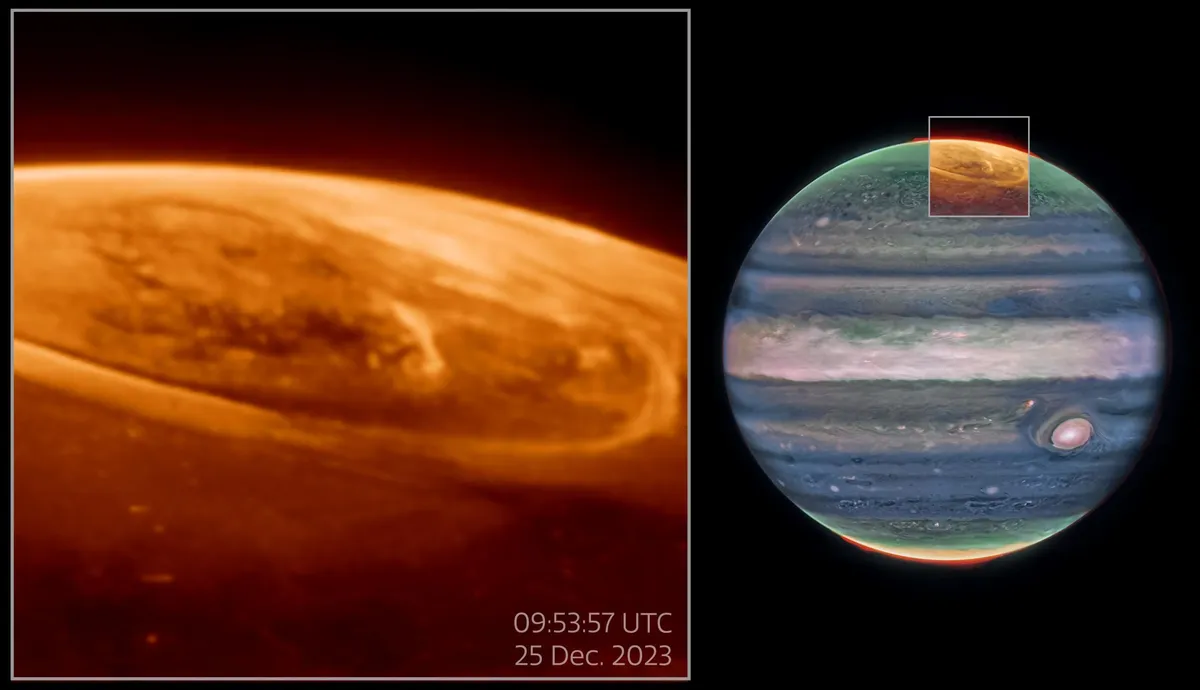
The James Webb Space Telescope has brought us closer to understanding the mesmerizing auroras that flicker, fluctuate, and undulate at Jupiter’s north pole. While Earth is known for its stunning Northern and Southern Lights, which are created when high-energy particles from the Sun collide with our magnetic field and atmosphere, Jupiter’s auroras are on an entirely different scale. These celestial light displays are not only significantly larger but also hundreds of times brighter than their terrestrial counterparts.
When astronomers directed NASA’s powerful James Webb Space Telescope towards the giant planet, they uncovered a captivating phenomenon: Jupiter’s auroras do more than simply glow; they burst and flicker like cosmic fireworks, changing dramatically within seconds. This unexpected behavior has provided scientists with a wealth of new information about Jupiter’s magnetic environment and the forces that drive these extraordinary displays.
On Earth, the auroras, commonly referred to as the Northern and Southern Lights, are enchanting displays characterized by shimmering colors such as red, green, and purple. These phenomena occur when solar particles interact with Earth’s upper atmosphere. In contrast, Jupiter’s auroras are fueled by a combination of solar particles and additional cosmic forces, making them even more intense and energetic.
One vital factor contributing to Jupiter’s powerful auroras is its immense magnetic field, which attracts charged particles from various sources, including its volcanic moon, Io. Known for its active volcanoes, Io ejects particles into space, creating a ring around Jupiter. When these particles, along with solar emissions, are captured by Jupiter’s magnetic field, they accelerate to extreme speeds, resulting in spectacular bursts of glowing light. The James Webb Space Telescope offers an unprecedented opportunity to observe these dynamic events.
On December 25, 2023, using its Near-Infrared Camera (NIRCam), the James Webb Space Telescope collected groundbreaking data revealing the auroras' rapid fluctuations. Led by Jonathan Nichols from the University of Leicester, the research team was astonished by the intensity and speed of these changes. “What a Christmas present it was – it just blew me away!” Nichols exclaimed. “We expected the auroras to fade in and out slowly, perhaps over a quarter of an hour or so. Instead, we observed the entire auroral region fizzing and popping with light, sometimes varying by the second.”
The team focused on emissions from the trihydrogen cation (H3+), a molecule formed in auroras. Their findings indicated that these emissions are far more variable than previously understood, providing crucial insights into the heating and cooling processes of Jupiter’s upper atmosphere. However, the researchers also encountered some puzzling observations that require further study.
What made these observations even more intriguing was the simultaneous imaging conducted with NASA’s Hubble Space Telescope. Surprisingly, the brightest light observed by Webb did not have a clear counterpart in Hubble’s images. This discrepancy has left scientists perplexed, as it suggests a rare combination of high quantities of very low-energy particles interacting with Jupiter’s atmosphere, a phenomenon previously thought to be impossible.
The research team is eager to delve deeper into the differences between the Hubble and Webb observations, aiming to uncover the broader implications for Jupiter’s atmosphere and space environment. Plans are underway for additional studies using the James Webb Space Telescope, which will be compared with data from NASA’s Juno spacecraft to elucidate the causes behind the enigmatic bright emissions observed.
The James Webb Space Telescope stands as the most advanced space science observatory ever constructed. Its mission is to explore the universe in unprecedented detail, shedding light on the mysteries of our solar system and beyond. As a collaborative effort involving NASA, the European Space Agency (ESA), and the Canadian Space Agency (CSA), Webb is revolutionizing our comprehension of the universe and our place within it.
These remarkable findings about Jupiter's auroras, published in the journal Nature Communications, highlight the ongoing journey of discovery and understanding facilitated by the James Webb Space Telescope. As scientists continue to unravel the complexities of Jupiter’s auroras, we gain invaluable insights into the planet’s atmosphere and the intricate dynamics of our solar system.